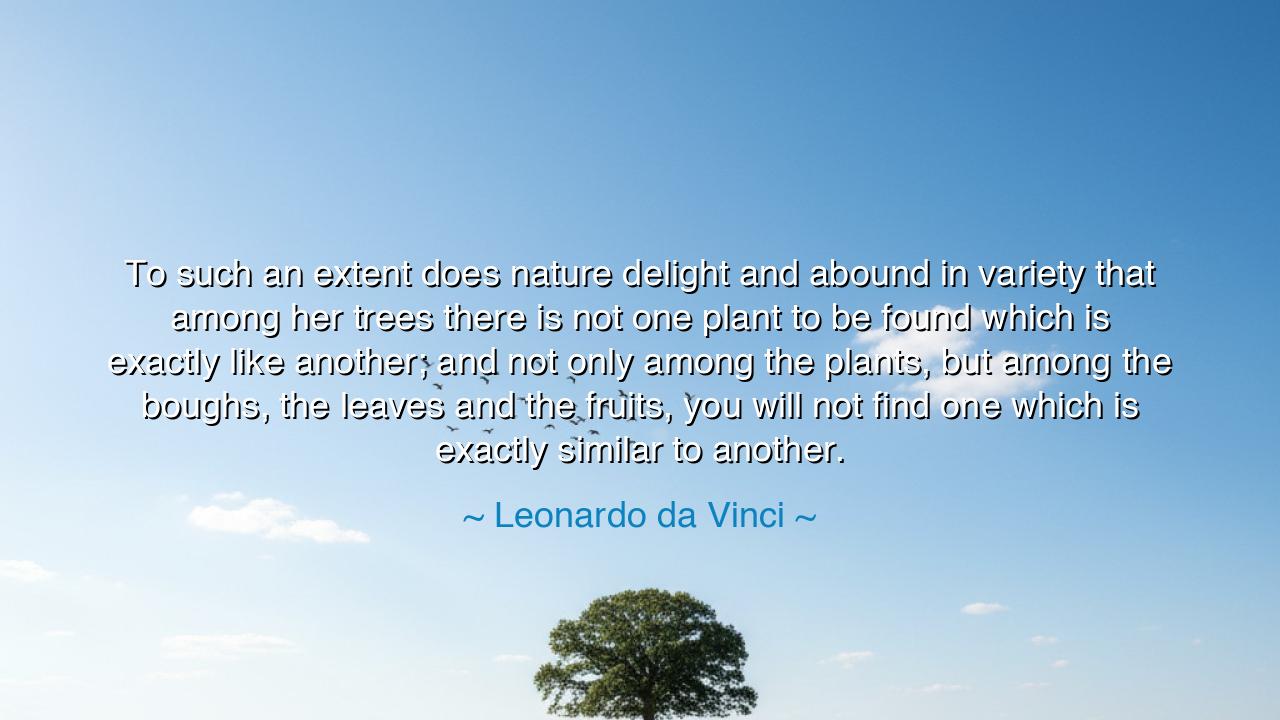
To such an extent does nature delight and abound in variety that
To such an extent does nature delight and abound in variety that among her trees there is not one plant to be found which is exactly like another; and not only among the plants, but among the boughs, the leaves and the fruits, you will not find one which is exactly similar to another.






The immortal genius Leonardo da Vinci, master of both art and science, once observed: “To such an extent does nature delight and abound in variety that among her trees there is not one plant to be found which is exactly like another; and not only among the plants, but among the boughs, the leaves and the fruits, you will not find one which is exactly similar to another.” In these words he captures the eternal richness of nature, whose greatest law is diversity. This is not mere casual remark, but the insight of a mind that studied every vein in a leaf, every curve of a branch, and found in them the signature of the divine.
Da Vinci’s meditation reveals the infinite variety of creation. The world is not fashioned like a coin stamped by a machine, each piece uniform and unchanging. Rather, it is alive with difference, each leaf turning at its own angle, each fruit bearing its own shade, each tree shaped by sun, wind, and soil. This variety is not chaos but harmony, a grand design woven from countless threads. In such richness, da Vinci saw both beauty and truth: beauty, because variety delights the senses; truth, because variety reveals the depth of the Creator’s imagination.
Consider his own art. In his paintings, no two faces are alike, no two gestures the same. He knew that the individuality of each form was what gave life to art. When he painted the folds of drapery, he observed how each fell differently. When he studied the human body, he saw that though all men share the same bones, each stands with a unique bearing, each carries within him a singular design. His genius was born from recognizing in nature’s variety the key to both realism and transcendence.
History confirms this wisdom beyond Leonardo’s art. The naturalist Charles Darwin, centuries later, would study the variety of finches in the Galápagos Islands. It was this diversity, subtle differences in beak and feather, that revealed the great law of evolution. Just as Leonardo had seen that no leaf is like another, Darwin saw that no creature is identical, and in that difference lay the strength of life. Variety was not weakness, but the very foundation of survival and progress.
The lesson is clear for human life as well. Just as no leaf is the same, so no human soul is identical. Each carries gifts, weaknesses, and paths unlike any other. To deny this variety is to deny the richness of creation. Societies that demand sameness, that crush individuality, become barren fields; but those that honor diversity, that celebrate each person’s distinctiveness, flourish like a forest. Leonardo’s observation is thus both scientific and moral: the variety of nature is a model for how we must live together as human beings.
Let us then embrace this teaching. Look at one another not with the eyes of comparison, but with the reverence of recognition. Just as each tree has its own form, each life has its own course. In our families, our schools, our nations, we must learn to cultivate uniqueness rather than erase it. To nurture individuality is to align with the law of nature itself; to demand sameness is to rebel against the very order of creation.
Practically, we can apply this wisdom by honoring differences—encouraging creativity in children, respecting cultures, celebrating talents that do not mirror our own. We should step into the fields, into the woods, and remind ourselves: just as no two leaves are the same, so every person we meet is a fresh expression of life’s abundance. To live with this awareness is to live in harmony with nature, with art, and with God.
Thus, Leonardo’s words resound across centuries: nature delights in variety. And if nature herself delights in it, should not we? Let us cast off the fear of difference and see in every unique form the poetry of existence. For in the infinite diversity of leaves and lives, we glimpse the infinite mind that made them all.






AAdministratorAdministrator
Welcome, honored guests. Please leave a comment, we will respond soon